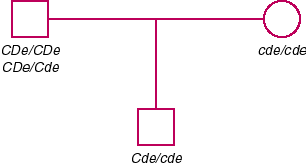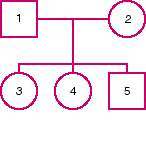

Applications Rh phenotyping is not routinely done an all patients. Although labs have different policies, Rh phenotyping may be done in the following circumstances:
Antisera Used Rh phenotyping is done using five antisera: anti-D, anti-C, anti-E, anti-c and anti-e. Note: Because anti-e is a rare, expensive antiserum, some labs do not use it unless the patient is positive with anti-E (if negative with anti-E, it can be assumed that the patient is e-positive).
Determination of Most Probable Genotypes Based on the results of the cell typing, all possible Rh genotypes are determined. Then, using known population frequencies, an educated guess is made as to the most probable genotype by selecting the most common genotype (Table 5-3). If more than one genotype is possible, only family studies can determine the actual genotype (Figure 5-4).
| anti- | ||||||
|---|---|---|---|---|---|---|
| C | D | E | c | e | Possibilities: | |
| Father | + | + | -- | -- | + | CDe/CDe or CDe/Cde |
| Mother | -- | -- | -- | + | + | cde/cde |
| Child | + | -- | -- | + | + | Cde/cde |
Looking at only the father, we would guess that he is most probably CDe/CDe because its frequency is 18% (whereas the frequency of CDe/Cde is less than 1%). However, when we take the child's typing into account, we can see that our guess as to the father's probable genotype was wrong. For him to have this child, he must be his rarer possibility, namely Cde/cde (Figure 5-4).

Answer questions on the Smith family, using the Rh phenotyping results in Table 5-4. E-mail replies to Pat.

| anti- | |||||
|---|---|---|---|---|---|
| C | D | E | c | e | |
| #1 | + | + | -- | + | + |
| #2 | -- | + | + | + | + |
| #3 | + | -- | -- | + | + |
| #4 | -- | + | + | + | + |
| #5 | + | + | + | + | + |
Express answers (Questions #1-6) in both Fisher-Race and shorthand nomenclatures.

| Rh Phenotype Determination | 
|